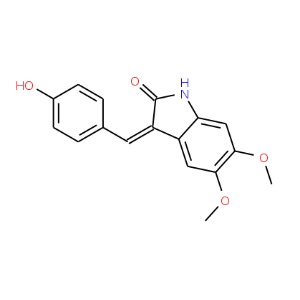| Cas No.: | 269730-03-2 |
| Chemical Name: | RET Receptor Tyrosine Kinase Inhibitor; 1,3-dihydro-5,6-dimethoxy-3-[(4-hydroxyphenyl)methylene]-H-indol-2-one; (3E)-3-[(4-hydroxyphenyl)methylidene]-5,6-dimethoxy-1H-indol-2-one |
| Synonyms: | RPI1,RPI 1 |
| SMILES: | C1=C(O)C=CC(/C=C2/C3=CC(OC)=C(OC)C=C3NC/2=O)=C1 |
| Formula: | C17H15NO4 |
| M.Wt: | 297.31 |
| Purity: | >98% |
| Sotrage: | 2 years -20°C Powder, 2 weeks 4°C in DMSO, 6 months -80°C in DMSO |
| Description: | RPI-1 is a specific, orally available 2-indolinone Ret tyrosine kinase inhibitor. RPI-1 inhibits proliferation, Ret tyrosine phosphorylation, Ret protein expression, and the activation of PLCgamma, ERKs and AKT in human medullary thyroid carcinoma TT cells. Antitumor activity[1]. |
| In Vivo: | RPI-1 (50, 100 mg/kg; p.o.; twice a day for 10 days) inhibits the tumor growth of TT xenografts by 81%[2]. Animal Model: 8- to 11-week-old female athymic nude CD-1 mice (bearing TT cells)[2] Dosage: 50, 100 mg/kg Administration: P.o.; twice a day for 10 days Result: A dose-dependent effect on tumor growth was observed, with a dose of 2*50 mg/kg/day resulting in less tumor weight inhibition than the 2*100mg/kg/day dose after 10 days of treatment. |
| In Vitro: | TPC-1 cells are sensitive to the growth inhibitory effect of RPI-1 with an IC50 of 5.1 μM, following 72 hours of treatment. RPI-1 (7.5-60 µM) inhibits Ret/Ptc1 autophosphorylation in TPC-1 cells. RPI-1 inhibitory effects in the TPC-1 cell culture conditions lead to inhibition of pathways involving JNK2 and AKT[1]. The RPI-1 IC50 value for cell proliferation is 3.6 µM in NIH3T3 cells expressing the Ret mutant compared with 16 µM in non-transfected NIH3T3 cells, and that for colony formation in soft agar was 2.4 µM and 26 µM in RET mutant-transfected and H-RAS-transfected NIH3T3 cells, respectively. In NIH3T3 cells expressing the Ret mutant, Ret protein and tyrosine phosphorylation were undetectable after 24 hours of RPI-1 treatment. In TT cells, RPI-1 inhibits proliferation, Ret tyrosine phosphorylation, Ret protein expression, and the activation of PLCgamma, ERKs and AKT[2]. |
| References: | [1]. Lanzi C, et al. Inactivation of Ret/Ptc1 oncoprotein and inhibition of papillary thyroid carcinoma cell proliferation by indolinone RPI-1. Cell Mol Life Sci. 2003;60(7):1449-1459. [2]. Cuccuru G, et al. Cellular effects and antitumor activity of RET inhibitor RPI-1 on MEN2A-associated medullary thyroid carcinoma. J Natl Cancer Inst. 2004;96(13):1006-1014. |

 DC Chemicals' products qualify for U.S. tariff exemptions. We guarantee no price increases due to customs duties and maintain stable supply, continuing to deliver reliable research solutions to our American clients.
DC Chemicals' products qualify for U.S. tariff exemptions. We guarantee no price increases due to customs duties and maintain stable supply, continuing to deliver reliable research solutions to our American clients.





















